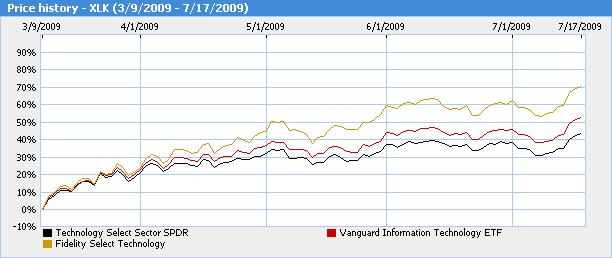The week past was a noteworthy one for technology investors. Share prices in this sector zoomed higher by 9.4%. After Tuesday’s market close, Intel’s (INTC) second quarter earnings announcement injected life back into the stock market and triggered a bull stampede in many tech names.
The Good
Intel reported its strongest growth from the first quarter to the second since 1988 and offered optimistic comments for the second half of 2009. Based on improving conditions in the PC market, the technology bellwether expects sales in the third quarter to near $8.5 billion, well above the $7.8 billion tally forecasted by analysts. Commenting on the chip giant’s results, one analyst quipped, ‘Intel had a blow-out quarter on nearly every metric.’
This bullish enthusiasm continued through the week after International Business Machines (IBM) too blew past analysts’ earnings forecasts. Relentless cost cutting through automation and shifting of work to lower cost locales enabled IBM to increase its profits by 12% to $3.1 billion even though sales declined 13% to $23.3 billion. IBM’s earnings tally of $2.32 a share exceeded analysts’ $2.02 a share forecast. The tech-titan bumped its 2009 EPS forecast higher to at least $9.70 a share, 50 cents a share more than its January forecast.
The Bad
Even though Intel and IBM reported relatively strong results, the strength in operations did not resonate through other tech names. Nokia’s (NOK) forward looking statement gave investors concern. Lagging rivals like Apple (AAPL) and Research In Motion (RIMM) in the smartphone race, Nokia lowered its operating margin forecast on phones from ‘mid teens’ to about 10%.
Citing weak demand for computer hardware from business customers, higher component costs, and a competitive pricing environment Dell (DELL) lowered its gross margin forecast for its July quarter.
Invest in Tech?
So, with tech companies performing mixed, is it worthwhile to invest in the technology sector?
Given the prospect of a stabilizing economy, I believe the answer is yes. Selectivity however is key.
Look Before You Leap!
Fidelity Select Technology (FSPTX), Technology Select Sector SPDR (XLK), and Vanguard Information Technology (VGT) represent a sampling of broad technology-related sector funds and ETFs available for investing. Here’s how these investments have fared since the March 9 market bottom.

FSPTX has led the pack with a whopping 70% return. This exceeds the 53% gain for VGT by 17%. XLK has lagged the group with a 45% advance.
Why Such Differences?
As always, the devil is in the details. While FSPTX, XLK, and VGT have Technology in their names, they are differ in market capitalization of holdings, industry exposure, and expense ratio. XLK includes telecom services companies while the others typically do not. FSPTX often includes mid-cap and small-cap technology companies while XLK and VGT are heavily oriented towards large-cap names.

Exposure to telecom services companies like AT&T and Verizon is holding back XLK’s performance while higher exposure to mid-cap names has helped FSPTX leapfrog the competition since March 9. Rather than choosing investments with the lowest expense ratio or highest trading volume, it pays to understand what your mutual fund or ETF owns.
While broad investments in the technology can fare relatively well, we believe richer rewards await those timing their entry into specific industries in the technology sector.

 Sick buying high & selling low? Fed up of the fees you pay? Tired researching investments? End your financial pain now. You have the opportunity to
Sick buying high & selling low? Fed up of the fees you pay? Tired researching investments? End your financial pain now. You have the opportunity to 

 DEC. 1993 to DEC. 2023
DEC. 1993 to DEC. 2023





